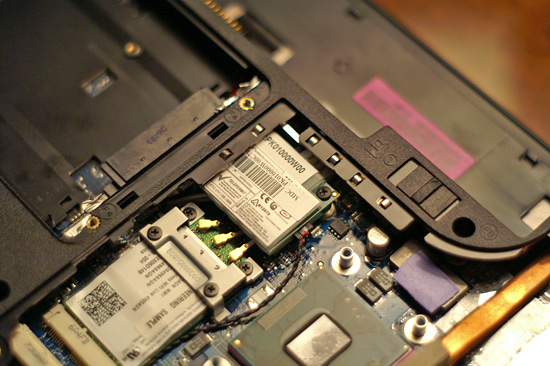Investigating Intel's Turbo Memory: Does it really work?
by Anand Lal Shimpi on June 19, 2007 3:39 PM EST- Posted in
- Laptops
Over a month ago Intel finally unveiled its fifth and most recent update to the Centrino platform, codenamed Santa Rosa.
Architecturally, Santa Rosa didn't offer much over its predecessor, Napa. The new platform bumped the FSB frequency to 800MHz, as well as introduced a new lower power FSB state (400MHz) to help keep power consumption in check while raising the peak performance bar. CPU clock speeds improved slightly due to the higher FSB, the fastest chip going from 2.33GHz to 2.40GHz, but overall performance hasn't been improved noticeably. Santa Rosa was the second Centrino platform to add 802.11n support, as its predecessor (Napa) was refreshed to include support for the new wireless standard.

The one unique feature that Santa Rosa offered that no other competing mobile platform, Intel or not, could bring to the table was a technology called Turbo Memory. An on-motherboard flash card, Intel's Turbo Memory is designed to act as another layer in the memory hierarchy, caching data where possible and improving performance/battery life in notebooks. A version of Turbo Memory will also be released for the desktop, but we're most interested in what it can do for notebooks.

In our Santa Rosa preview we found that Turbo Memory did very little in fact. Performance didn't improve (in some cases it got worse), we couldn't find any measurable reduction in power consumption and in the end we found absolutely no use for the technology. Notebook makers echoed our sentiments, with both HP and Sony declining to use Intel's Turbo Memory in their Santa Rosa lineups, but Intel insisted that there was an upside to the technology.
We met with Intel engineers to understand a bit more about Turbo Memory and why we weren't able to see any positive results out of it. Intel's explanation and the resultant lightbulb that lit in our heads, led to the production of this article.










31 Comments
View All Comments
SilthDraeth - Wednesday, June 20, 2007 - link
NVM. I think I understand. The "Windows XP startup" is a test that "PCMark '05" runs.Thanks.
DigitalFreak - Wednesday, June 20, 2007 - link
They really should have dedicated the entire 1GB to ReadyDrive instead of splitting it.Nighteye2 - Tuesday, June 19, 2007 - link
I miss the test of readyboost at 2GB of memory. Does the technology still improve performance even when you have a lot of memory?Azsen - Tuesday, June 19, 2007 - link
It does sound like Microsoft need to rework the code for Readyboost and Turbo memory to make use of the extra flash memory more. From the benchmarks it doesn't look like it's being used to its full potential at all. They also need to rework the code so it's enabled after one reboot, not a whole lot of reboots. That's shocking.androticus - Tuesday, June 19, 2007 - link
A technology so persnickety, complicated, and without any significant real world benefits and often just more slowdowns is a total loser!And 512M of cache supposed to in any way adequately cover the huge hard disks of today? Including swap file?
yzkbug - Tuesday, June 19, 2007 - link
My take is to go with a flash-based hard-drive (when prices come down). It should give all benefits that the Turbo Memory was supposed to bring: drain less power and have quick random seeks.Roy2001 - Tuesday, June 19, 2007 - link
Agree.Pirks - Tuesday, June 19, 2007 - link
this poor soul together with his lover beenthere would just jump from joy reading this article. expect usual assortment of MICROSUCKS and INTEL SCAM and shit like that.what's the most funny here is that this is the only case where he would be pretty close to truth, ain't that amusing huh
pnyffeler - Tuesday, June 19, 2007 - link
While I may agree that the impact is minimal, you still have to tip your hat to Intel. Power saving in laptops is probably not going to see revolutionary changes. While 5-10% may not seem like much, it's better than not having it.Besides, what's to say that the impact might be much larger with a larger cache. You could argue that at the extreme end, the longest the battery life could be extended to would be if there was no hard drive at all, just the flash drive. If that were true, then the max the battery life could be under this scheme is the battery life with only a flash drive. How does that compare to these numbers?
And finally, what gives with only 1 GB of flash? If an iPod with 8GB of flash costs $250, I'd pay that much for 8 GB in my laptop if it would make a big enough difference.
TA152H - Tuesday, June 19, 2007 - link
Anand,You're missing something quite significant on ReadyBoost. You talk about adding another gigabyte of memory like there is only a financial cost involved, but this isn't so. If you add more memory to laptop, you use more power, emit more heat, etc... If you can get similar performance for a part that uses less power (it would be interested to know how much power it does use), you extend battery life as well as save money, and don't suffer a huge performance penalty. So, it's actually quite useful.